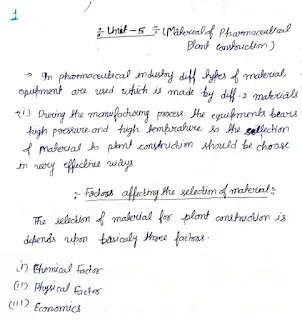Pharmaceutical Engineering Unit 2 Notes PDF Download
Download comprehensive notes for Pharmaceutical Engineering Unit 2 in PDF format. Key topics include heat transfer, evaporation, and distillation. Detailed coverage of principles, equipment, and applications. Ideal for pharmaceutical engineering students and professionals.
Keywords: Pharmaceutical engineering, Unit 2, heat transfer, evaporation, distillation, Fourier's law, heat exchangers, evaporators, steam jacketed kettle, horizontal tube evaporator, climbing film evaporator, forced circulation evaporator, multiple effect evaporator, simple distillation, flash distillation, fractional distillation, steam distillation, molecular distillation, PDF, notes, download.
Pharmaceutical Engineering Unit 2: Mastering Heat Transfer, Evaporation, and Distillation
Pharmaceutical Engineering Unit 2 builds upon the foundational knowledge by delving into the principles and applications of heat transfer, evaporation, and distillation – crucial processes in pharmaceutical manufacturing. This content outlines key topics covered within this unit and their significance.
1. Heat Transfer
Heat transfer is the process of thermal energy exchange between physical systems, essential for controlling temperature in various pharmaceutical operations. Key topics include:
- Objectives & Applications: Heating, cooling, sterilization, pasteurization, and maintaining optimal reaction temperatures.
- Heat Transfer Mechanisms:
- Conduction: Heat transfer through a solid material due to a temperature gradient.
- Convection: Heat transfer through a fluid (liquid or gas) due to the movement of the fluid.
- Radiation: Heat transfer through electromagnetic waves without a medium.
- Fourier's Law: Describes conductive heat transfer, stating that the rate of heat transfer is proportional to the temperature gradient and the area through which heat is transferred.
- Heat Interchangers & Heat Exchangers: Devices used to transfer heat between two fluids without mixing them. Types include shell and tube, plate, and finned heat exchangers.
2. Evaporation
Evaporation is the process of converting a liquid into a vapor by heating it, used for concentrating solutions in pharmaceutical manufacturing. Key topics include:
- Objectives & Applications: Concentrating solutions, recovering solvents, and preparing dry extracts.
- Factors Influencing Evaporation: Temperature, pressure, surface area, and humidity.
- Differences Between Evaporation and Other Heat Processes: Understanding the distinctions between evaporation, boiling, and drying.
- Evaporator Types:
- Steam Jacketed Kettle: A simple evaporator where a steam jacket provides heat.
- Horizontal Tube Evaporator: Uses horizontal tubes to heat the liquid.
- Climbing Film Evaporator: The liquid forms a thin film on the inner surface of the tubes, enhancing evaporation.
- Forced Circulation Evaporator: Uses a pump to circulate the liquid rapidly, preventing scaling.
- Multiple Effect Evaporator: Uses vapor from one evaporator as a heat source for another, increasing efficiency.
- Economy of Multiple Effect Evaporator: The ratio of water evaporated to the steam consumed, indicating the efficiency of the system.
- Principles, Construction, Working, Uses, Merits & Demerits: Detailed study of each evaporator type to understand their advantages and limitations.
3. Distillation
Distillation is the process of separating components of a liquid mixture by selective boiling and condensation, crucial for purifying pharmaceutical compounds. Key topics include:
- Basic Principles: Separating components based on differences in boiling points.
- Simple Distillation: Used to separate liquids with large differences in boiling points.
- Flash Distillation: A single-stage separation where a liquid mixture is partially vaporized.
- Fractional Distillation: Used to separate liquids with close boiling points using a fractionating column.
- Distillation Under Reduced Pressure: Lowering the pressure to reduce the boiling points of heat-sensitive compounds.
- Steam Distillation: Used to separate volatile compounds that are immiscible with water by introducing steam into the mixture.
- Molecular Distillation: A vacuum distillation technique used to separate high-boiling point, heat-sensitive compounds.
- Methodology: Detailed understanding of the process, including the equipment and techniques used for each distillation type.
Significance in Pharmaceutical Manufacturing
These concepts are crucial for pharmaceutical manufacturing because they are involved in various processes, including:
- Purification of APIs: Distillation is used to purify active pharmaceutical ingredients (APIs).
- Solvent Recovery: Evaporation is used to recover solvents for reuse.
- Sterilization and Pasteurization: Heat transfer is used to sterilize equipment and pasteurize solutions.
- Formulation: Heat transfer and evaporation are used in the preparation of pharmaceutical formulations.
Applications
- API Manufacturing: Distillation and evaporation are critical steps in the synthesis and purification of APIs.
- Process Optimization: Understanding heat transfer allows for the optimization of heating and cooling processes.
- Quality Control: Ensuring the purity and concentration of pharmaceutical products.
In summary, Pharmaceutical Engineering Unit 2 provides essential knowledge and skills in heat transfer, evaporation, and distillation, which are fundamental to the design, operation, and optimization of pharmaceutical manufacturing processes. These notes are a valuable resource for students and professionals seeking a comprehensive understanding of these key concepts.
Info!
If you are the copyright owner of this document and want to report it, please visit the copyright infringement notice page to submit a report.

